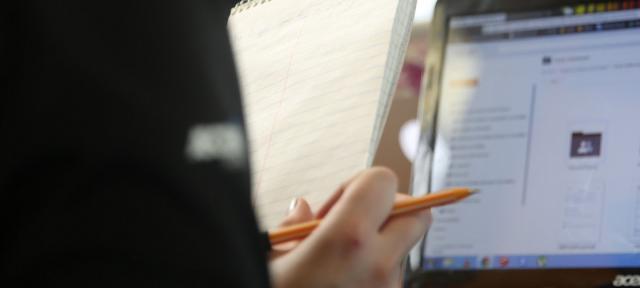Art by Numbers

Habitual Cathexis: An Encyclopedic Box Project
Andrea White sees connections everywhere, and they show up aplenty in her final project.
After four years of helping friends hang their Div III shows, the Philadelphia native thinks of the college gallery as much more than space waiting to be filled and wanted to use it "to address the Hampshire community." She had noticed that students frequently wander into exhibitions from two nearby locations, the campus mailroom, 15 feet from the gallery door, and the library, just up a short flight of stairs.
Her reflections on the gallery and what she jokingly calls her "scientific, obsessive interest in information acquisition and organization" led to a Div III, "Habitual Cathexis: An Encyclopedic Box Project," that creatively combines photography, collage, art history, a new take on the mail art movement of the 1960s, word play, statistical probability, and random collaboration with other Hampshire students.
First, she turned to the library where, she said, she became obsessed with the Oxford English Dictionary and the poetics of language. Then, she added together the digits of 1,680 student mailboxes until each cooked down to a single number. (For mailbox 1680, one plus six plus eight plus zero equaled 15, which became one plus five, or six.) Eventually, every mailbox number added up to "one" through "nine."
White created nine different forms of small photography and art projects for the nine mailing groups—a total of 1,680 art objects. Each included directions on how to assist with the project, and was connected by string to a shipping tag bearing a quote from the OED about that mailing group's number. She sent these out in random mailings.
Group one, for example, got a double-sided, transparent-paper pocket. One side held a collage on a square photographic negative, with the emulsion melted into oddly beautiful golden hues. These came with directions to create something, fill the other pocket and return it. The tagged quote read, "the equation…being to establish a 'ONE-to-ONE' correspondence between the two integral spaces."
Group six was no doubt startled to receive, out of the blue, a blank frame waiting to be filled, attached to a tag bearing the quote "____ was as dead now as ____ would be when they lowered ____ SIX feet under."
White photographed every object prior to mailing, and made a book of the 1,680 photos. As items returned, she replaced the original photo with one of the new creation and its arrival date.
"It's funny how ritualistic the whole thing became," she said.
She got back 150 items and, knowing some mailboxes are not in use, estimated a six to ten percent return rate. Many of the returned items contained political statements about current events as the respondents' contributions to the project. Her show will include graphs of boxes she decided were empty, "the pseudoscientific portion" of the project, a riff on experimental poetry created by blacking out words within text.
"I keep detailed records. It's the terms of my engagement with art," she explained. "Obsessive cataloging becomes a form of playfulness."
She plans to incorporate even those items mailbox owners threw away: "I went dumpster diving and have a trashcan full."
White became interested in "points of creativity within a small section within tiny parameters" while taking a course called "The Collector" with photography and film professor Robert Seydel and art history professor Sura Levine. Seydel, chair, and Levine became her Div III committee.
For White, the Div III has involved massive amounts of research, creation, and record keeping, plus staging a gallery show. She compared its endurance demands, "the level and ambition to which you can take work," to her high school experience rowing crew, in terms of "the furthest I've ever pushed myself mentally and physically."
Her future plans include graduate school and work either in film art direction and production design or as a curator.

